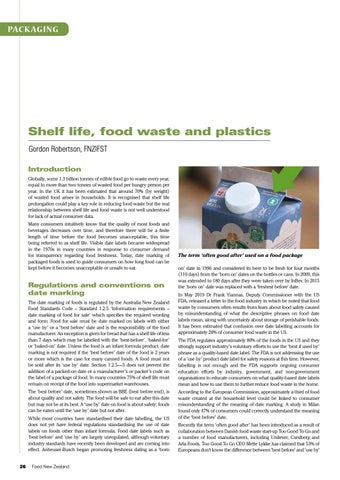Packaging
Shelf life, food waste and plastics Gordon Robertson, FNZIFST Introduction Globally, some 1.3 billion tonnes of edible food go to waste every year, equal to more than two tonnes of wasted food per hungry person per year. In the UK it has been estimated that around 70% (by weight) of wasted food arises in households. It is recognised that shelf life prolongation could play a key role in reducing food waste but the real relationship between shelf life and food waste is not well understood for lack of actual consumer data. Many consumers intuitively know that the quality of most foods and beverages decreases over time, and therefore there will be a finite length of time before the food becomes unacceptable, this time being referred to as shelf life. Visible date labels became widespread in the 1970s in many countries in response to consumer demand for transparency regarding food freshness. Today, date marking of packaged foods is used to guide consumers on how long food can be kept before it becomes unacceptable or unsafe to eat.
Regulations and conventions on date marking The date marking of foods is regulated by the Australia New Zealand Food Standards Code – Standard 1.2.5 ‘Information requirements – date marking of food for sale’ which specifies the required wording and form. Food for sale must be date marked on labels with either a ‘use by’ or a ‘best before’ date and is the responsibility of the food manufacturer. An exception is given for bread that has a shelf life of less than 7 days which may be labelled with the ‘best-before’, ‘baked-for’ or ‘baked-on’ date. Unless the food is an infant formula product, date marking is not required if the ‘best before’ date of the food is 2 years or more which is the case for many canned foods. A food must not be sold after its ‘use by’ date. Section 1.2.5—5 does not prevent the addition of a packed-on date or a manufacturer’s or packer’s code on the label of a package of food. In many countries 75% of shelf life must remain on receipt of the food into supermarket warehouses. The ‘best before’ date, sometimes shown as BBE (best before end), is about quality and not safety. The food will be safe to eat after this date but may not be at its best. A ‘use by’ date on food is about safety; foods can be eaten until the ‘use by’ date but not after. While most countries have standardised their date labelling, the US does not yet have federal regulations standardising the use of date labels on foods other than infant formula. Food date labels such as ‘best before’ and ‘use by’ are largely unregulated, although voluntary industry standards have recently been developed and are coming into effect. Anheuser-Busch began promoting freshness dating as a ‘born 26
Food New Zealand
The term ‘often good after’ used on a food package on’ date in 1996 and considered its beer to be fresh for four months (110 days) from the ‘born on’ dates on the bottles or cans. In 2009, this was extended to 180 days after they were taken over by InBev. In 2015 the ‘born on’ date was replaced with a 'freshest before' date. In May 2019 Dr Frank Yiannas, Deputy Commissioner with the US FDA, released a letter to the food industry in which he noted that food waste by consumers often results from fears about food safety caused by misunderstanding of what the descriptive phrases on food date labels mean, along with uncertainty about storage of perishable foods. It has been estimated that confusion over date labelling accounts for approximately 20% of consumer food waste in the US. The FDA regulates approximately 80% of the foods in the US and they strongly support industry’s voluntary efforts to use the ‘best if used by’ phrase as a quality-based date label. The FDA is not addressing the use of a ‘use by’ product date label for safety reasons at this time. However, labelling is not enough and the FDA supports ongoing consumer education efforts by industry, government, and non-government organisations to educate consumers on what quality-based date labels mean and how to use them to further reduce food waste in the home. According to the European Commission, approximately a third of food waste created at the household level could be linked to consumer misunderstanding of the meaning of date marking. A study in Milan found only 47% of consumers could correctly understand the meaning of the ‘best before’ date. Recently the term ‘often good after’ has been introduced as a result of collaboration between Danish food waste start-up Too Good To Go and a number of food manufacturers, including Unilever, Carslberg and Arla Foods. Too Good To Go CEO Mette Lykke has claimed that 53% of Europeans don't know the difference between 'best before' and 'use by'




